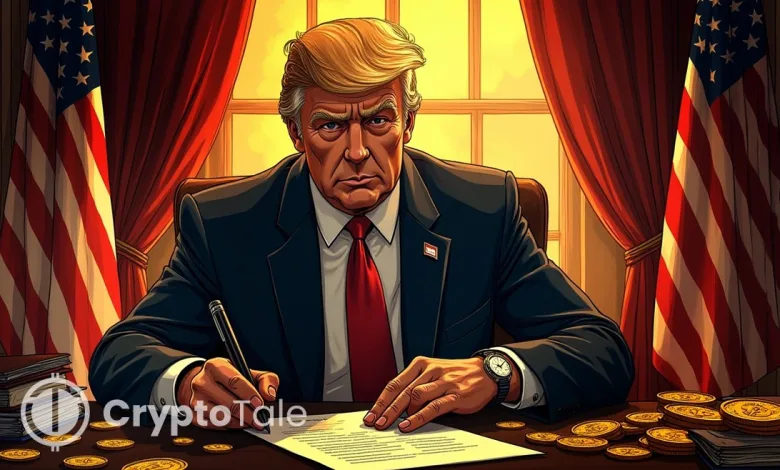Trump’s First 100 Days Rock Crypto and Global Markets

- Trump’s policies created tension in both digital assets and traditional stocks.
- The launch of a government Bitcoin reserve was a historic and unexpected move.
- New tariffs rattled global markets as investors feared inflation and slowing growth.
Making use of his second innings as President, Donald Trump garnered global attention with his bold and controversial policies. As Trump completes 100 days in office, he has redefined America’s stance on digital finance and global trade. His initiatives spurred volatility in traditional and crypto markets alike, reshaped regulatory landscapes, and reignited nationalist trade rhetoric, prompting one central question: Will this era mark the beginning of sustainable crypto-driven American leadership or a period of destabilizing economic experimentation?
Crypto Roots and Pro-Blockchain Appointments
On January 20, 2025, as Donald Trump was sworn in as the 47th President of the United States, financial markets were closed due to Martin Luther King Jr. Day. That same day, a Trump-linked decentralized finance venture, World Liberty Financial, launched its second WLFI token sale. The Trump family, reported to own a 60% stake in the firm and collect 75% of token revenue, sparked immediate scrutiny over potential conflicts of interest.
Trump quickly placed pro-crypto allies in high-level regulatory roles. Paul Atkins was nominated as Chair of the Securities and Exchange Commission. David Sacks was appointed head of the President’s Council of Advisors on Science and Technology, and Brian Quintenz was appointed Chair of the Commodity Futures Trading Commission. Each brought a known preference for crypto innovation over regulatory restriction.
In a parallel announcement that drew both praise and criticism, Trump established the Department of Government Efficiency, led by Elon Musk as senior advisor. DOGE aimed to streamline federal spending and leverage blockchain for governmental transparency. However, critics raised concerns over aggressive cost-cutting and the department’s lack of oversight, particularly after Musk reduced his role to part-time.
Tariffs, Pardons, and Early Market Reactions
On January 21, 2025, President Trump announced 25% tariffs on imports from Mexico and Canada, set to take effect on February 1. Despite initial concerns, U.S. markets rallied, with the S&P 500 and Dow Jones posting gains. Analysts attributed the surge to investor optimism about Trump’s pro-business policies and expectations of future tax cuts. However, Morgan Stanley cautioned that the rapid policy shifts could introduce market volatility and economic uncertainty in the coming months.
On January 22, 2025, President Trump granted a full and unconditional pardon to Ross Ulbricht, founder of the Silk Road darknet marketplace. Ulbricht had been serving a life sentence since 2015 for operating Silk Road, which facilitated over $200 million in illegal transactions using Bitcoin. Trump announced the pardon via Truth Social, stating he had called Ulbricht’s mother to inform her of the decision, citing support from the Libertarian Movement as a motivating factor. The pardon fulfilled a campaign promise Trump made at the 2024 Libertarian National Convention.
Moving forward, Executive Order 14178, “Strengthening American Leadership in Digital Financial Technology,” was signed by President Trump on January 23, 2025. Citing worries about national sovereignty, financial stability, and individual privacy, this directive forbids government agencies from creating, issuing, or promoting central bank digital currencies (CBDCs) domestically or internationally. Additionally, it created a Presidential Working Group to create a regulatory framework for digital assets and revoked earlier instructions on CBDCs.
On January 26, 2025, Elon Musk announced plans to integrate blockchain technology into the Department of Government Efficiency, aiming to enhance transparency, secure data, and monitor federal spending. The initiative seeks to modernize federal operations by leveraging blockchain to track expenditures and reduce inefficiencies. While the proposal has garnered attention for its innovative approach, it has also sparked discussions regarding potential challenges in implementation and oversight.
Escalation in February: Trade Wars and Crypto Fear
On February 1, 2025, President Trump signed executive orders imposing significant tariffs: 25% on imports from Mexico and Canada (with Canadian energy exports taxed at 10%) and 10% on Chinese goods. Citing concerns over border security and fentanyl trafficking, these measures aimed to pressure trading partners into stricter enforcement. Effective from February 4, the tariffs prompted swift retaliation from the affected countries, leading to heightened trade tensions and market volatility. Economists warned of potential inflation and economic slowdown as a result of the escalating trade disputes.
On February 3, 2025, U.S. financial markets declined sharply following President Trump’s announcement of new tariffs. Investors grew concerned about potential economic slowdown and inflationary pressures. Major indices like the S&P 500 and Dow Jones Industrial Average experienced significant losses. The cryptocurrency market also suffered, with Ethereum, XRP, and Cardano dropping in value. Crypto futures faced approximately $2.2 billion in liquidations, reflecting heightened investor anxiety. Analysts warned that these developments could signal prolonged market volatility and economic uncertainty.
On February 19, 2025, the S&P 500 closed at a record high of 6,144.15, marking the peak of the index during President Trump’s first 100 days in office. Despite this milestone, the cryptocurrency market exhibited caution. The Crypto Fear & Greed Index stood at 44, indicating a sentiment of fear among investors. Additionally, trading volumes in the crypto market increased by nearly 21%, suggesting heightened activity amid market uncertainty.
On February 28, 2025, Bitcoin’s price fell below $80,000 for the first time since November, reaching a low of $78,273. This decline was driven by multiple factors, including investor concerns over President Trump’s impending tariffs on Mexico, Canada, and China, which heightened fears of inflation and slowed economic growth. Additionally, a significant $1.5 billion hack of the Bybit exchange further eroded confidence in the cryptocurrency market. As a result, Bitcoin’s value dropped by over 25% from its January peak of $109,000, leading to substantial losses across the broader crypto market.
Related: Paul Atkins Calls For Clear Crypto Rules at SEC Roundtable
Bitcoin Reserve and A Market on Edge
As February closed, Trump continued to take measures in the market. As the new month of March started, Trump imposed tariffs on Canadian and Mexican imports, imposing a 25% charge and a 10% tax on Canadian energy goods and increasing Chinese import tariffs from 10% to 20%. These actions were intended to address border security and fentanyl trafficking issues, but investors were disappointed. The stock market responded negatively, with the S&P 500 falling 1.8% and the Nasdaq-100 falling 2.6%. Analysts were concerned that rising trade tensions might cause inflation and a recession.
On March 6, 2025, President Trump signed an executive order establishing the Strategic Bitcoin Reserve and U.S. Digital Asset Stockpile. The reserve is capitalized with approximately 200,000 bitcoins seized through criminal and civil proceedings, positioning the U.S. as the largest known state holder of bitcoin. The government will not sell these assets, aiming to use them as a long-term store of value, akin to gold. This move aligns with Trump’s goal to make the U.S. the “crypto capital of the world”.
During remarks at the White House on the same day, amid market volatility following tariff implementations, Trump stated, “I’m not even looking at the market,” emphasizing a long-term perspective over short-term fluctuations.
On March 7, 2025, crypto industry leaders, including Michael Saylor, Brian Armstrong, and David Sacks, convened at the White House to discuss digital asset regulation. Notably absent was Cardano founder Charles Hoskinson, who expressed surprise at not being invited despite Cardano’s ADA token being included in the reserve. Hoskinson emphasized that meaningful regulatory change requires Congressional action.
On March 9, 2025, President Trump, during an interview on Fox News’ “Sunday Morning Futures,” declined to rule out the possibility of a recession. He described the U.S. economy as undergoing a “period of transition,” emphasizing the significant changes his administration was implementing. Trump stated, “I hate to predict things like that. There is a period of transition because what we’re doing is very big. We’re bringing wealth back to America. That’s a big thing.” He added, “It takes a little time. It takes a little time.”
On March 13, 2025, the S&P 500 entered correction territory, closing 10.1% below its February 19 peak, marking its first correction since 2023. This decline was driven by escalating trade tensions, notably President Trump’s imposition of 25% tariffs on steel and aluminum imports from all countries, effective March 12. In response to concerns about these tariffs, Trump stated, “No, I’m not going to bend at all on aluminum or steel or cars. We’re not going to bend. We’ve been ripped off as a country for many, many years.” The market’s downturn reflected investor apprehension over potential inflation and economic slowdown resulting from the trade policies.
Related: TRUMP Token Unlock: Could It Trigger a Sell-Off or Rebound?
Liberation Day, Regulatory Shift, and Gold Soars
April began with the dramatic “Liberation Day” announcement. On April 2, Trump rolled out “reciprocal” tariffs ranging from 10% to 50% on 57 countries. As he held a chart of affected nations, markets tumbled. Futures dropped: S&P 500 by 3.9%, Nasdaq by 4.7%. In addition to that, on April 3, Trump proclaimed, “The markets are going to boom,” brushing off the reaction. “We’ve been ripped off for years,” he told reporters on the White House South Lawn.
Then came a regulatory pivot. On April 9, Paul Atkins was confirmed as SEC Chair by a 52–44 Senate vote. His crypto-forward stance signaled a loosening of digital asset restrictions and a departure from Gary Gensler’s tenure.
In a continuation of the regulatory saga, Federal Reserve Chair Jerome Powell, speaking on April 16, issued a stark warning: tariffs could worsen inflation and impede economic growth. “The Fed will proceed cautiously,” he said, acknowledging policy complications
On April 22, investors turned to gold. Prices hit a historic $3,500 per troy ounce amid fears of Fed instability. Trump clarified he would not fire Powell, reversing an earlier social media outburst: “I have no intention,” Trump told reporters, softening tensions that rattled markets earlier that week
Finally, on April 29, Bitcoin fell 10.2% below its January highs. Market jitters combined with the rise of Trump-themed meme coins like Bonk, Floki, and Pengu, driven by speculative hype. Experts warned of high risks amid surging activity, suggesting these coins resembled “lottery tickets” more than investments
Redefining Market Norms
From the outset of his presidency, Donald Trump set the tone for an administration deeply involved in reshaping the digital economy and trade landscape. His appointments reflected a commitment to advancing blockchain and crypto, while his unpredictable tariff policies sent shockwaves through global markets.
Though he claimed markets would “boom,” his first 100 days saw everything from record highs in equities and gold to severe crypto drawdowns and correction territory for major indices. As Bitcoin reserves mount and policy uncertainty persists, markets brace for what comes next in a presidency that continues to defy expectations, one executive order at a time.





